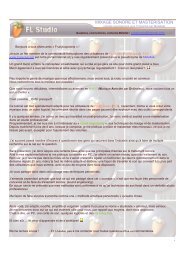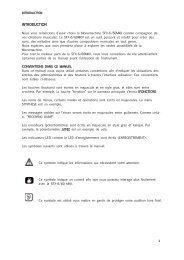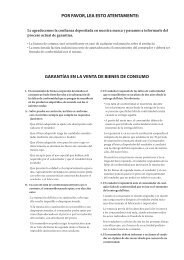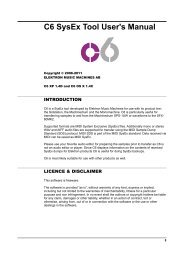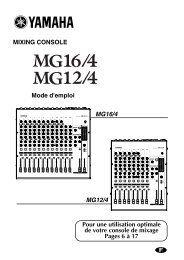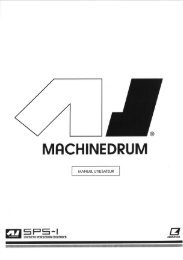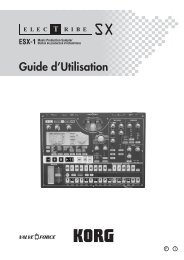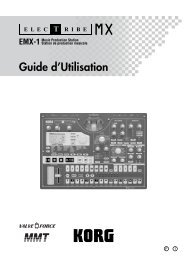Access Virus User Manual - SoundProgramming.Net
Access Virus User Manual - SoundProgramming.Net
Access Virus User Manual - SoundProgramming.Net
You also want an ePaper? Increase the reach of your titles
YUMPU automatically turns print PDFs into web optimized ePapers that Google loves.
ACCESS VIRUS OS4 89<br />
The Audio Outputs<br />
THE AUDIO OUTPUTS<br />
In MULTI mode, you can choose a<br />
mono or stereo audio output in the<br />
OUTPUT Select menu independently<br />
for every PART. The signal<br />
can also be routed to the aux<br />
buses that were discussed earlier.<br />
In addition, you may also define a<br />
second mono or stereo output in<br />
the SECOND OUTPUT menu (under<br />
the CTRL menu). This second output<br />
is global, in other words, it<br />
applies to all PARTs. Using the SEC-<br />
OND OUTPUT Balance parameter,<br />
you can set the levels at which the<br />
output signals of the PARTs are<br />
routed to this second output individually.<br />
In conjunction with the conventional<br />
output of the given sound,<br />
you end up with a quadraphonic<br />
signal that is suitable for Surround<br />
applications. Using Panorama (left,<br />
right) and the SECOND OUTPUT<br />
Balance (front, back), you can create<br />
a genuine quadraphonic mix in<br />
the <strong>Virus</strong> and automate it via a<br />
sequencer.<br />
When you opt to use one of the<br />
aux buses as a second output, the<br />
aux bus can also serve as an FX<br />
loop. You can route the aux signal<br />
to a PART and have the PART process<br />
this signal (via filters, effects<br />
etc.) further.<br />
In contrast to the majority of other<br />
effects, the delay/reverb section is<br />
not available individually for each<br />
PART. Instead, it processes the signals<br />
of the PARTs collectively. You<br />
can, however, control the intensity<br />
of the effect individually for each<br />
PART using the respective Effect<br />
Send parameter. Consequently, the<br />
delay/reverb section has just one<br />
signal output, which cannot be distributed<br />
to the outputs of the individual<br />
PARTs.<br />
This is why, for example, the delay<br />
effect of a PART that is routed to<br />
the pair of outputs labeled OUT 2<br />
will still be audible on OUT 1. This<br />
can be desirable yet may also lead<br />
to confusion. To encourage the<br />
former and prevent the latter, set<br />
the Effect Send parameter of the<br />
PART to zero when you’re using<br />
individual outputs.



